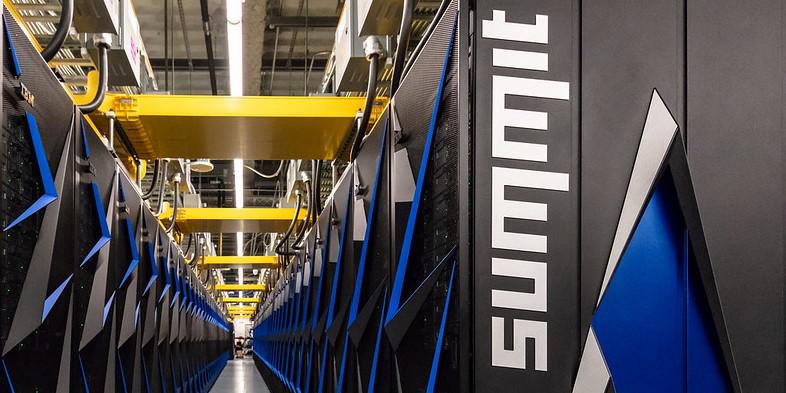Supercomputer Models Coronavirus Vulnerabilities
A national laboratory supercomputer used to model neutron star collisions now is peering into inner space to explore potential vulnerabilities in COVID-19. The Summit supercomputer at Oak Ridge National Laboratory (ORNL), described by officials there as the world’s most powerful and smartest, is matching small-molecule drug compounds against the coronavirus in the hope of blunting the virus’s activities on two fronts.
Scientists there already have ranked 13,000 molecules by their effectiveness against a drug target on the virus, and that number is growing. These targets tend to be proteins that serve different functions on the virus, and scientists have focused on them because a drug hindering their activities could blunt or even stop the virus from spreading or attacking human hosts.
Jeremy Smith, director of the ORNL Center for Molecular Biophysics, explains that COVID-19 has a spike protein on its surface that recognizes and binds with a human host. Being able to neutralize this spike protein would stop it from binding with potential human victims, he points out. Other proteins that the virus makes—or that humans make for it—are part of the virus’s reproductive process. Disabling those proteins can prevent the virus from multiplying to wreak its havoc on humans.
Smith, who also is the governor’s chair for molecular biophysics at the University of Tennessee, Knoxville, cites “a tsunami of experimental information that has come in from throughout the world” for helping inform and improve the supercomputer’s computational models. “We rely on experiments to give us information upon which to base our computational models,” he says. “These experiments tend to [give us] high-resolution three-dimensional structures of the viral targets—the proteins. It allows us to make more accurate, more precise computational models that have higher predictive value—figuring out which chemicals might be useful drugs.”
Smith continues that the database of chemicals the computer is evaluating are substances that could be brought rapidly to use on humans. They would require no long-term safety testing by drug authorities because they already are approved for human consumption. “If any of these works, it should be relatively quick to obtain approval to use them widely,” Smith maintains.
The 13,000 molecules are ranked only according to the proteins the supercomputing team has targeted. As the laboratory obtains more detailed simulation models, the ranking accuracy will increase, along with its usefulness, Smith says. Each potential target generates separate rankings, which then are consolidated to provide a comprehensive picture.
The virus only produces about 20 proteins through its human hosts, Smith reports. All 20 of those proteins generated by viral genome are potential targets for drug counterattacks. Simulation models of counter-virus drugs will be put out to the research community for further exploration by others, while ORNL will pursue virtual high throughput screening of chemical candidates against all potential drug targets on the virus.
The ORNL is working with national laboratories and universities, and experimental teams already are testing chemical compounds. These tests determine several factors, including whether the compound binds to the protein and whether it works on a live virus. Smith relates that the ORNL is working with a laboratory that has a live COVID-19 virus to test whether favorable compounds can stop the contagion. Test results are fed back into the computer models to improve their accuracy.
Some of the ORNL’s research allies have put in requests for specific molecules to be simulated against the virus, Smith notes. But a compound’s efficacy cannot be fully determined until the lab has done a complete screening for all viral proteins and established a final ranking, he says. The ORNL only can focus on the spike protein and a couple of others, he says.
Exploring the effectiveness of compounds is not the only part of this work. “In order to evaluate which compounds work, you have to understand the virus’s secrets,” Smith declares. “You have to understand how the virus functions, how the virus does its business.” Successfully interfering with the virus’s activities requires a detailed description of how it works, and that is part of the ORNL’s anti-virus computations.
One challenge is that COVID-19 already is mutating, although it seems to be happening quite slowly, Smith offers. Viruses mutate, usually becoming entirely different viruses than originally defined. The world could see a COVID-20, COVID-21 or COVID-22 in coming years. A drug that successfully challenges COVID-19 could be rendered ineffective by a random mutation within the virus, and that possibility lurks in the background if scientists cannot wipe it out completely—which currently does not seem likely, Smith says.
But the large number of diverse allies offers hope that a countervirus drug could be developed as a result of these supercomputer simulations. “I’m having huge drug companies come up to me saying, ‘Look. Let’s forget intellectual property; let’s put everything we can to solving this problem and never mind payment considerations,’” Smith relates. “Cooperating like that, and the energy the bright young scientists are putting into that, is inspirational to me.”






Comments